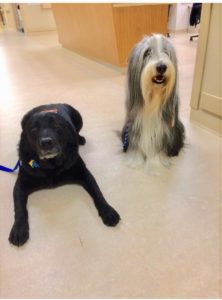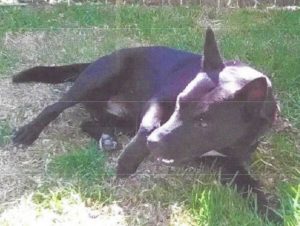∙Two members of the U.S. House of Representatives re-introduced a bill that would make malicious acts of animal cruelty a felony nationwide. A person convicted of the crime could face a fine or up to seven years in prison, or both.
The bill, known as the Preventing Animal Cruel and Torture (PACT) Act, is co-sponsored by Democrat Ted Deutch and Republican Vern Buchanan. PACT would criminalize “crushing, burning, drowning, suffocating and impaling animals.” The measure would also address bestiality and other attempts to sexually exploit animals.
The legislation contains exceptions for hunting, veterinary care, and actions necessary to protect life or property from a serious threat from an animal.
The Humane Society Legislative Fund supports the measure, noting that while most states consider certain acts of animal cruelty a felony, some penalties are still considered misdemeanors. The bill earned 284 bipartisan co-sponsors and more than 200 law enforcement endorsements in the previous session of Congress.

∙Larger-brained dogs outperform smaller dogs on measures of executive functions—a set of cognitive processes that are necessary for controlling and coordinating other cognitive abilities and behaviors. In particular, bigger dogs have better short-term memory and self-control than smaller ones, according to the study in Animal Cognition.
“The jury is out on why, necessarily, brain size might relate to cognition,” says lead study author Daniel Horschler, an anthropology doctoral student and member of the University of Arizona’s Arizona Canine Cognition Center. “We think of it as probably a proxy for something else going on, whether it’s the number of neurons that matters or differences in connectivity between neurons. Nobody’s really sure yet, but we’re interested in figuring out what those deeper things are.”
Canine brain size does not seem to be associated with all types of intelligence, however. Horschler found that brain size didn’t predict a dog’s performance on tests of social intelligence, which the researchers measured by testing each dog’s ability to follow human pointing gestures. It also wasn’t associated with a dog’s inferential and physical reasoning ability.
The study’s findings mirror what scientists have previously found to be true in primates—that brain size is associated with executive functioning, but not other types of intelligence.
Horschler’s study uses data from more than 7,000 purebred domestic dogs from 74 different breeds. Breed standards offered estimates of brain size.
∙By Beth Mueller
Acne plagues many teenagers and even adults, but did you know that animals get pimples too? Dr. Jason Pieper, a board-certified veterinary dermatologist at the University of Illinois Veterinary Teaching Hospital in Urbana, sees a few cases of pet acne every year.
Acne occurs when a hair follicle becomes plugged. Hair follicles lie within the skin. They cradle the root of a hair shaft, which grows out of the middle of the follicle, and supply the hair with protective oils from attached glands.
The chin is the most common location for acne in dogs and cats. Sometimes the acne can be seen around the lips and muzzle. It may appear red, brown, or black (like a blackhead), or it may look like pustules (pimples).
One theory is that the acne is a result of damage to the hair follicle, for example, when the pet drinks water from its bowl and repeatedly bumps its chin. A damaged hair follicle may become plugged with oils.
To treat acne, it is important to keep the area clean and dry. The chin and muzzle area are often wet from drinking, which can predispose that area to reoccurring acne. Pet owners can use a washcloth to gently clean the area.
New Year’s resolutions for the pet owner.
I will schedule my pet’s yearly wellness exam with her veterinarian. I will ensure that my pet remains up to date on her vaccinations and invest in another year of flea, tick and heartworm preventative for her.
I will speak with my veterinarian about the healthiest diet for my pet and work to feed him a high-quality diet. I will avoid overfeeding him, understanding that obesity in dogs and cats leads to many health problems and a reduced quality of life.
I will give my pet an informal in-home exam every month, being sure to look inside her ears, examine her eyes for discharge or other changes, lift her tail to ensure she has a clean and healthy rear end, and pet her carefully all over to check for lumps, bumps or wounds. I will contact my veterinarian promptly if I notice anything new or amiss.
I will invest in new toys for my pet. Even though he chews most of them up, I will find a way to incorporate chew toys into my budget if these are his favorite. When I cannot meet his demand for chew toys, I will invest in puzzle toys, activity feeders, bones and other enrichment items that allow him to chew and destroy without breaking the bank.
I will clean up after my pet so that her litterbox or yard is clean and free of feces.
I will practice calling my pet to come for a treat at least once a day, using a clear and happy voice and calling by name (“Fido, Come!”) I will try this from various rooms in the house and also the yard, and will practice more often if I notice he does not reliably come when called. I will remember that cats can learn to come when called, too, and will save my cat’s favorite treats or toys to be delivered when I call him to me.
REWARD LOST DOG.
XENA – Black, medium sized Shepherd mix 5 years old.
Wearing red collar with her license and tag with Xena and phone# 805-207-0235.
If you see her, please contact
Nancy Broadhead 805-207-0235
or
Cappi Patterson 805-766-5920

